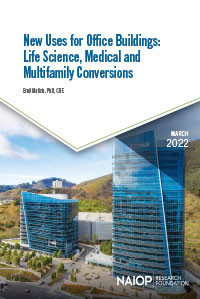A Fresh Look at Office Conversions

Old office buildings find a new lease on life as labs, medical offices and apartments.
The COVID-19 pandemic has led to the steepest decline in demand for office space since the Great Recession. Offices largely went unused in the first months of the pandemic, and office utilization rates have yet to fully recover. The long-expected return to the office was delayed by subsequent waves of coronavirus variants. Although the decline in infections from the Omicron variant has led many employers to announce a return to the office, many employers plan to offer employees a hybrid work schedule for the foreseeable future, dampening demand for office space.
The pain in the office sector has not been evenly shared. A tight labor market has supported demand for Class A buildings with attractive layouts and amenities that employers can use to lure workers back to the office. By contrast, older office buildings that offer few amenities to compete with the comforts of home have suffered the most from the decline in demand. And while demand for traditional office space is down, demand for flex and specialized office space for life science and medical office uses has grown in many markets.
Favorable demand trends for life science, medical office and multifamily properties have led some developers to look at traditional office buildings that are approaching functional obsolescence as potentially attractive targets for conversion to new uses. The NAIOP Research Foundation has published a report titled “New Uses for Office Buildings: Life Science, Medical and Multifamily Conversions,” by Emil Malizia, Ph.D., research professor at University of North Carolina at Chapel Hill. Malizia interviewed commercial real estate practitioners, examined market data and reviewed secondary sources to evaluate the trends driving developer interest in office conversions and describe the risks and opportunities associated with these projects.
Evaluating Suitability for Conversion
The report provides an overview of the factors that affect whether a given office building will be a good candidate for conversion. As in any project, location is a critical factor. Most life science conversions occur near existing clusters of research facilities operated by pharmaceutical companies, universities, hospitals and government agencies, which are not present in every market. While markets like Boston, San Diego and San Francisco have historically hosted a large share of life science conversions, they also occur in growing life science markets like Austin, Seattle and the Maryland suburbs of Washington, D.C.
Office-to-multifamily conversions occur in a larger number of markets, but they tend to be concentrated in denser urban areas where multifamily units are in short supply. A traditional office building may be a good candidate for conversion to medical office if it is easily accessible from a nearby highway, located near hospitals and other specialized medical facilities, and in an area with a growing population.
A building’s structural elements can also affect whether a conversion would be viable. For example, to be a candidate for a life science conversion, a multistory building should have a floor-to-ceiling clearance of at least 14 feet, and buildings with large floor plates and wide column spacing are usually better-suited to laboratory space. Nor can every office building accommodate optimal apartment layouts. Narrow, low-rise buildings and mid- or high-rise buildings with a centralized interior core may be suitable for multifamily conversion, but it is harder to divide the floors of wider buildings that lack a central core into apartments with comfortable layouts and adequate daylight.
Advantages of Conversion
When a conversion is feasible, it offers several advantages over demolition and new construction. It is often easier to obtain permits for a conversion, which usually causes less disturbance to surrounding buildings. Conversion also tends to be quicker than new construction, and material and labor costs are usually lower. Faster project completion is a particular advantage in the life science sector, where firms often seek to lease space shortly after obtaining FDA approval for a new product.
When converting a multistory building, it may also be feasible to lease floors that are not currently undergoing conversion, providing the owner with a source of income during construction. Another significant advantage is that conversion can be more sustainable than new construction. It requires less energy and building materials and preserves much of the existing building’s embodied carbon.
Current market conditions make conversion of older office buildings more attractive than before the pandemic. However, not all office buildings are viable candidates for conversion, and relative demand for traditional office, life science, medical office and multifamily space will continue to shift in response to economic conditions. Nonetheless, the report demonstrates that conversion will remain a viable strategy for underperforming office buildings when adjacent uses are more profitable.
Shawn Moura, Ph.D., is the director of research for NAIOP.
 Get the Report To view and download “New Uses for Office Buildings: Life Science, Medical and Multifamily Conversions,” visit naiop.org/Research-and-Publications/Research-Reports. |




